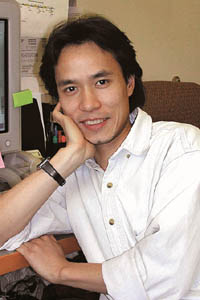University study challenges a conventional theory in evolution
By Catherine GianaroMedical Center Public Affairs
 Bruce Lahn | |
New data suggest that the accumulation of genetic changes is not solely determined by natural selection. A study by University researchers contradicts conventional theory by showing that the percentage of mutations accepted in evolution also is strongly swayed by the speed at which new mutations arrive at a gene: the faster the speed of new mutations, the greater the percentage of those mutations accepted.
“We’ve discovered a striking phenomenon that challenges a paradigm of molecular evolution that has been around for several decades,” said lead author Bruce Lahn, Assistant Professor in Genetics and a Howard Hughes Medical Institute investigator. “As such, it may cause a significant shift in the field.”
The researchers reported their findings in the July issue of the journal Trends in Genetics. Other authors are Gerald Wyckoff, previously a postdoctoral fellow in Lahn’s lab and now an assistant professor at the University of Missouri-Kansas City, and Christine Malcom and Eric Vallender, both graduate students who work with Lahn.
For more than three decades, molecular evolutionists have thought that no matter how many genetic mutations show up on a specific gene, whether or not those mutations become fixed in the species is determined primarily by natural selection. The new study shows that the speed at which these new mutations arrive also affects whether the mutations become fixed.
Lahn’s team looked at nearly 6,000 genes in their study. For each gene, they compared sequences between two mammalian species. This enabled them to measure the synonymous mutation rate, called Ks. These mutations do not affect the protein’s structure; they are functionally neutral, which means natural selection is not a factor in whether they are accepted during evolution.
Lahn’s team also looked at the rate of mutations that do affect protein structure and are typically subject to natural selection, called Ka. These nonsynonymous mutations will get accepted into or bounced out of the population based on how the mutation alters protein function. The researchers then studied the Ka/Ks ratio, which measures the percentage of nonsynonymous mutations accepted in evolution.
Regardless of the rate of new mutations at a particular gene, scientists have always presumed that the percentage of nonsynonymous mutations, those affecting protein structure, which are accepted during evolution, remains constant.
“This theory has been the workhorse of molecular evolution,” Lahn said. “Thousands of scientific papers have been published based directly or indirectly on this notion.”
The new data show that if more mutations show up at a gene, that gene tends to accept a higher percentage of those mutations.
“A gene under strong mutational pressure succumbs to that pressure,” Lahn said. “For genes that have a high mutation rate, somehow selection appears to become less stringent.”
Lahn cannot explain the mechanism of his findings and expects many will question this novel result. “It’s too radical,” he said. “People just don’t want to believe it, but the data are there.”
Geneticist James Crow, professor emeritus of genetics and zoology at the University of Wisconsin-Madison, said, “Lahn and his associates have found a most striking result, one that is totally unexpected. If this result is indeed confirmed, it would cast doubt on use of this ratio [Ka/Ks] as an indicator of selection.”
Sudhir Kumar, an associate professor of molecular evolution at Arizona State University, agreed. “It goes against strict theory, but evolutionary biologists know that nothing’s clean cut. There’s always distortion because we’re looking at longtime history.
“The novelty of this work is that he [Lahn] used a large amount of data,” Kumar said. “It’s a perfect example of the power of the genome project.”
Crow added, “I hope that further work will provide an explanation of what now is a major puzzle.”
![[Chronicle]](/images/sidebar_header_oct06.gif)